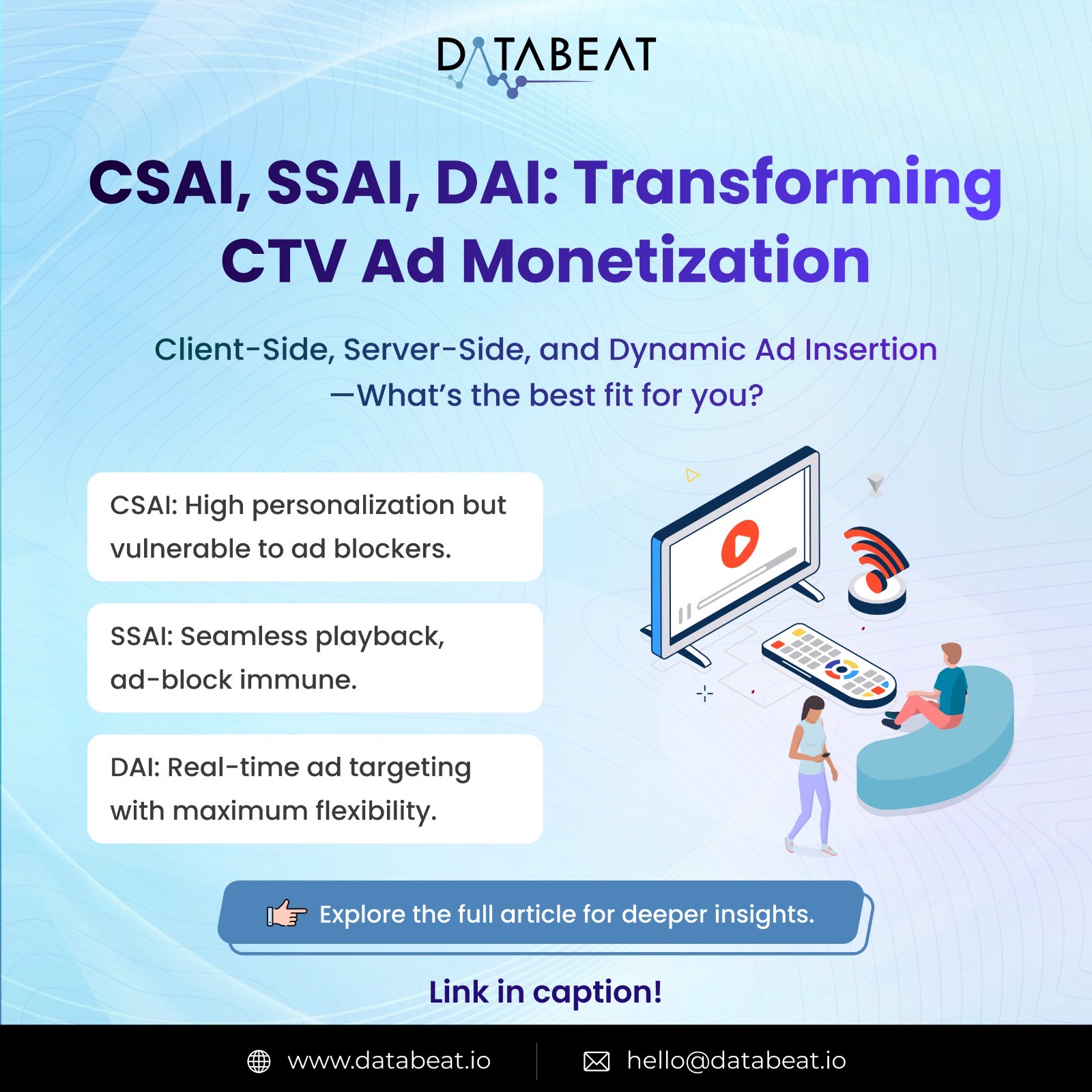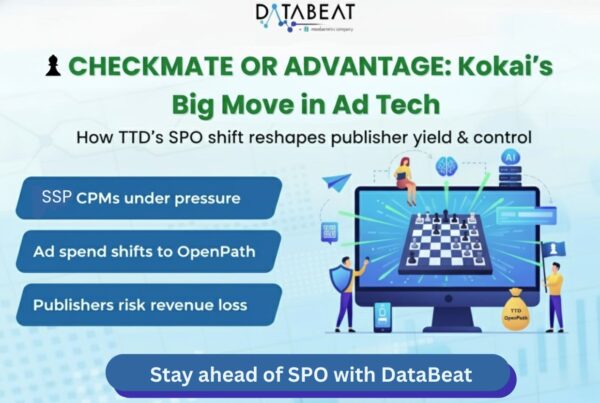
Ad Insertion is a key strategy that enables video publishers to effectively monetize their content, which seamlessly integrates commercial video spots into the video content.
As per the current trends in the area of CTV/Over-The-Top (OTT) video advertising, three technologies stand out:
- Client-Side Ad Insertion (CSAI),
- Server-Side Ad Insertion (SSAI), &
- Dynamic Ad Insertion (DAI).
These techniques will help content producers to optimize income, enhance experience and maximize ads distribution. Let’s focus on each approach further in order to understand its pros, cons, and case studies in OTT video advertising.
Client-Side Ad Insertion (CSAI)
Client-side Ad Insertion (CSAI) (also known as Client-Side Ad Stitching), dynamically requests and inserts ads on the client side, such as in browsers or apps.This process starts when the client sends a request to the ad server, which then provides the ad for playback.
These advertisements are usually downloaded in advance and saved on the device. High personalization and flexibility are possible with CSAI; but, if the internet connection is sluggish or the ad files are huge, there is a higher chance of ad blocking and a delay in ad loading or user experience disruptions.
Key Components:
- CTV Player SDK: This is the software running on the TV or streaming device (e.g., Roku SDK, Fire TV SDK, etc.) that fetches the content and ads.
- Ad Server: Provides ads in response to ad calls made by the player.
CDN (Content Delivery Network): Delivers video content separately.

Illustration of CSAI Framework
Here’s how CSAI works:
- Fetching video content: Before a video starts playing, the player downloads the file from the CDN when the user clicks the play button.
- For pre-roll ads, these ads play before the main video begins.
- Request to the Ad Server: When the video player hits an ad marker, it pauses the video and sends a request to the ad server for an ad.
- Ad Response: In return, the ad server typically sends back a VAST XML (or VMAP, VPAID, etc.) that includes details about the advertisement, its media, and tracking information.
- Once the ad finishes, the video player picks up where it left off using the data it received.
Streaming platforms often integrate SDKs from either first- or third-party ad verification services into their video players. These SDKs track the ad’s position, completion rates, and any errors, sending that information back to the servers periodically.
Technical Characteristics:
- Ads are managed by the client’s device (client-side).
- Vulnerable to ad blockers and buffering.
- SDK is responsible for fetching both content and ads.
What is Server-Side Ad Insertion (SSAI)?
Server-Side Ad Insertion (SSAI), commonly referred to as Ad Stitching, shifts the ad insertion procedure to the server side in contrast to CSAI. This method involves server-side integration of advertisements into the video stream prior to the viewer seeing them. The aforementioned procedure encompasses transcoding, encoding, and content adaptation to many streaming formats, hence guaranteeing compatibility and seamless playback across diverse devices and network configurations.
Regardless of the user’s device specifications or internet speed, SSAI guarantees smooth and continuous video playback, resulting in a more consistent user experience. Real-time ad distribution and targeting are supported as well, with additional advantages including improved ad performance.
Key Components:
- SSAI Platform: A server-side platform like AWS Elemental MediaTailor or Brightcove that stitches ads into the content stream.
- Ad Decision Server (ADS): Determines which ads to serve based on data such as user behavior or demographics.
CDN: Delivers the stitched stream (content + ads) to the device.

Illustration of SSAI Framework
Here’s how SSAI works:
- Signal to Stitching Service: The publisher sends a message to the ad-stitching service indicating the start of a VOD or live stream.
- Request Ads via Ad Call: The ad-stitching service then requests ads from the ad server. For VOD, this is usually done using VMAP or In-line VMAP with VAST, while for live streams, it involves a formatted ADS ad call for the specific break.
- Send VAST: The ad server responds with a VAST tag that includes a mezzanine file and ready-to-serve files. The SSAI vendor downloads the highest available bitrate. If the creative has already been processed and transcoded, it moves to the next step. If the response is a Wrapper tag, the ad-stitching service extracts the inner InLine response using the same logic as a client-side media player.
- Extract Mezzanine and Transcode: The ad-stitching service retrieves the unique creative identifier from the VAST tag. If this creative hasn’t been used before, the mezzanine file is extracted and transcoded. If it cannot be processed, the ad is skipped, and the next available ad plays instead, with a VAST error code 407 sent.
- Select Transcoded: If the creative in the VAST tag matches an identifier for a previously transcoded ad, the ad-stitching service selects the pre-transcoded file from the system.
Technical Characteristics:
- Ads are stitched server-side, ensuring a seamless stream.
- Immune to ad blockers.
- Better experience for live content (e.g., sports) as there’s no buffering during ad transitions.
Dynamic Ad Insertion (DAI):
Dynamic Ad Insertion (DAI) is the forefront of ad insertion technology in OTT video advertising. Unlike CSAI and SSAI, which rely on static ad placements, DAI is a method of ad insertion that delivers ad content in real-time, allowing for greater flexibility and targeting of the ad content.
DAI is similar to CSAI and SSAI in that it involves inserting ads on the client side, but it differs in that the ad content is delivered in real-time. This enables real-time ad targeting based on user behavior and preferences, and it allows for more precise ad placement, which can result in higher engagement and conversion rates.
Here’s how DAI works:
- The web page or app loads the IMA SDK.
- The IMA SDK makes a request to the Ad Server DAI cloud service for content.
- The cloud service returns ads and content stitched together as a single stream.
- The video player plays this stream.
- The IMA SDK loads impression pixels.
The primary advantage of DAI is its ability to deliver personalized ad experiences at scale. By utilizing advanced algorithms and machine learning, DAI can analyze large volumes of data in real-time to present relevant ads to individual viewers, maximizing engagement and conversion rates. Additionally, DAI provides exceptional flexibility, enabling advertisers to modify ad creatives, targeting parameters, and pricing models on the fly to enhance campaign performance.
However, implementing DAI requires a robust infrastructure and sophisticated ad-serving capabilities. Content providers must invest in scalable video delivery systems, ad decisioning platforms, and data analytics tools to fully leverage DAI’s potential. Moreover, ensuring seamless integration with existing workflows and third-party ad networks presents a significant technical challenge.
Technical Characteristics:
- Enables personalized ad targeting based on real-time data.
- Works with both CSAI and SSAI, but the actual ad insertion still depends on the method used (client-side or server-side).
Which Ad Insertion technology should be used?
The choice among CSAI, SSAI, and DAI depends on several factors, including audience demographics, content type, monetization goals, and technical capabilities. CSAI offers precise targeting and personalization, while SSAI excels in ad viewability and resistance to ad blocking. DAI, on the other hand, provides dynamic, data-driven ad experiences but requires significant investment in infrastructure and technology.
Ultimately, content providers must assess their specific needs and objectives to identify the most suitable ad insertion technology for their OTT video advertising strategy. Whether the goal is maximizing revenue, enhancing user engagement, or optimizing ad delivery, selecting the right approach is crucial for unlocking the full potential of OTT video advertising.
How can DataBeat help?
At DataBeat, we specialize in various video ad insertion techniques and are here to support you in every step of the way. Whether you need assistance with setting up your campaigns, troubleshooting issues, or maximizing the monetization of your inventory, our expertise can make a significant difference. Additionally, we offer in-depth analysis of campaign data and provide tailored optimization services to enhance performance and drive better results. Let us help you unlock the full potential of your video advertising efforts!









